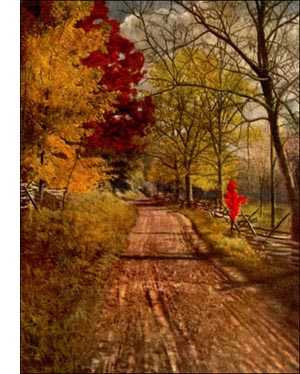Fringe Tree
 Fringe Tree (Chionanthus Virginica, Linn.)-A slender, narrow-headed tree, 20 to 30 feet high, or less. Bark reddish, scaly; branches grey or brown. Wood light brown, close, heavy, hard. Buds small, brown, ovate; inner scales becoming leaf-like.
Fringe Tree (Chionanthus Virginica, Linn.)-A slender, narrow-headed tree, 20 to 30 feet high, or less. Bark reddish, scaly; branches grey or brown. Wood light brown, close, heavy, hard. Buds small, brown, ovate; inner scales becoming leaf-like. Leaves opposite, simple, 4 to 8 inches long, 1 to 4 inches broad, smooth, except on veins below, dark green, paler below, oval or oblong on short petioles; yellow in early autumn. Flowers, May and June, perfect, white, each with 4 slender, curving petals 1 inch long, in graceful, pendulous clusters.
Fruit in September, clustered 1-seeded drupes, 1 inch long, dark blue, with slight bloom; flesh dry; skin thick. Preferred habitat, rich, moist soil on banks of streams. Distribution, southern Pennsylvania to Florida; west to Arkansas and Texas. Uses: Admirable ornamental tree, hardy to New England. Much planted in parks and gardens.
The fringe tree's beauty when its belated leaves unfold, and the delicate fringe-like flowers cover it like a bridal veil, is quite sufficient justification for the tree's existence. I do not know but that it adds to its charm to wait till the orchard has done blooming and lilacs and all the early things have passed, making us long for something new and different to come and take their places.
A delicate fragrance comes out of the purple-dotted hearts of these drooping blossoms and the daintiness of the whole tree at this supreme moment of its life history is something to be seen and felt-one cannot put it into words. Later the leaves broaden and the blue fruits are unusual and quite ornamental in late summer. But the tree has become substantial looking, and somewhat commonplace. Its ethereal beauty belongs to its blooming period.
Chion means snow, anthos, a flower. There is as much beauty in this Greek name as in the flowers it describes. The light and graceful clusters of snow-white petals are indeed like feathery masses of snowflakes. The elegance and singularity of its flowers and fruit give the fringe tree high rank among the native flowering trees suitable for lawn and garden.
In Europe it is planted as a beautiful exotic from America. Because it grows wild Americans have been slower to introduce it into cultivation. A species with shorter, broader petals in erect, compact clusters has been found in China. This cannot compare with our own species in grace and beauty.